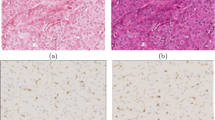Synopsis
Haematoxylin and its oxidation products were studied by t.l.c., and i.r., n.m.r., u.v. and visible spectroscopy. Oxidation (‘ripening’) of Haematoxylin with oxygen, from the atmosphere or a cylinder, gave Haematein as the only major product; whereas with non-gaseous oxidants such as hydrogen peroxide, potassium permanganate and sodium iodate, further oxidation readily occurred. Such ‘over-ripening’ always produced the same major product: a yellowish quinone-carboxylic acid, which we term ‘Oxyhaematein’. Oxyhaematein did not form a complex with aluminium ions under staining conditions but did act as an acid dye. Thus the deleterious effects of the overripening of Haematoxylin and the reported yellow-orange acidophil background staining sometimes seen with metal-Haematoxylin stains may both be explained. However, an additional, or alternative, explanation is available for this orange staining: acidic solutions of Haematein were found to react with acidophils of tissue sections to give an orange-brown product, not extracted by the processing fluids.
Similar content being viewed by others
References
Arshid, F. M., Connelly, R. F., Desai, J. N., Fulton, R. G., Giles, C. H. &Kefalas, J. C. (1954). A study of certain natural dyes II. The structure of the metallic lakes of the Brazilwood and Logwood colouring matters.J. Soc. Dyers Col. 70, 402–12.
Baker, J. R. (1958).Principles of Biological Microtechnique. pp. 174&190. London: Methuen.
Baker, J. R. (1962). Experiments on the action of mordants. 2: Aluminium-haematein:Quart. J. micr. Sci. 103, 493–517.
Bentley, K. W. (1960).The Natural Pigments. New York: Interscience Publishers.
Brand, J. C. D. &Dglinton, G. (1964).Applications of Spectroscopy of Organic Chemistry, London: Oldbourne Press.
Braude, E. A. (1945). Studies in light absorption. Part I.p-benzoquinones.J. chem. Soc. 490–7.
Chaberek, S. &Martell, A. E. (1959).Organic Sequestering Agents, p. 130. New York: Wiley.
Davenport, H. A. (1964).Histological and Histochemical Technics. Philadelphia: Saunders.
Duff, D. J. (1950). Logwood colouring matters. Some notes on their constitution: Haematoxylin and Brazilin related: structural formulae; Logwood lakes as pigments.Dyer 103, 271–3.
Dngles, P., Perkin, W. H. &Robinson, R. (1908). Brazilin, Haematoxylin, and their derivatives. Part IX. On Brazilin, Haematein and their derivatives.J. chem. Soc. 93, 1115–62.
Imes, N. K., Sanders, D. C., Crane, C. R. &Clarke, G. (1969). Assaying actual haematein content of commercial haematoxylins and haemateins.Stain Tech. 44, 167–72.
Lalor, G. C. &Martin, S. L. (1959). Studies on haematoxylin and haematein, the colouring principles of logwood. I. Absorption spectra of pure compounds in various solvents and a spectrophotometric method of analysis for haematoxylin and haematein.J. Soc. Dyers Col. 75, 13–17.
Lillie, R. D. (1969).Conn's Biological Stains. 8th Ed. Baltimore: Williams & Wilkins.
Mayer, F. (1943).The Chemistry of Natural Colouring Matters, New York: Rheinhold.
Palmer, R. W. &Lillie, R. D. (1965). Spectroscopic and staining studies of the ripening and over-ripening of aluminium haematoxylins.Histochemie 5, 44–54.
Schwarz, J. C. P. (1964).Physical Methods in Organic Chemistry. London: Oliver & Boyd.
Silverstein, R. M. &Bassler, G. C. (1967).Spectrophotometric Identification of Organic Compounds. 2nd Ed. New York: Wiley.
Terner, J. Y., Gurland, J. &Gaer, F. (1964). Phosphotungstic acid haematoxylin; spectrophotometry of the lake in solution and in stained tissue.Stain Tech. 39, 141–53.
Thompson, S. W. (1966).Selected Histochemical and Histopathological Methods. Springfield, Illinois: Charles C. Thomas.
Author information
Authors and Affiliations
Rights and permissions
About this article
Cite this article
Marshall, P.N., Horobin, R.W. The oxidation products of Haematoxylin and their role in biological staining. Histochem J 4, 493–503 (1972). https://doi.org/10.1007/BF01011129
Received:
Issue Date:
DOI: https://doi.org/10.1007/BF01011129




